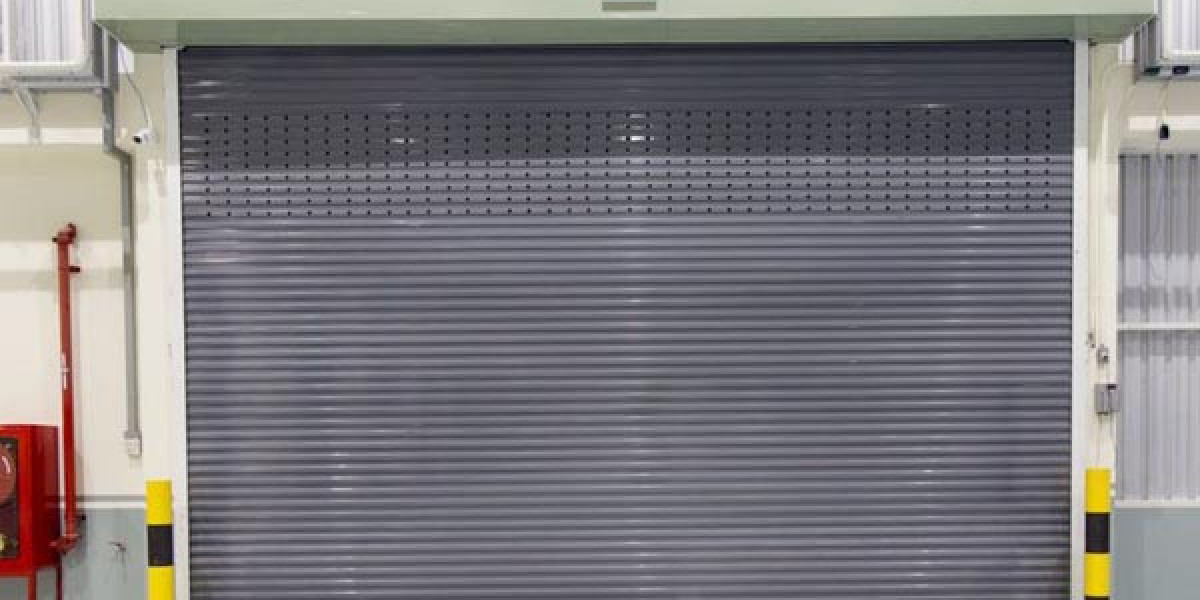Industrial Roll Up Doors are a practical solution designed for the demanding needs of industrial and commercial environments. Their compact operation allows the door to roll neatly into a coil above the opening, ensuring minimal obstruction and maximum use of available space. These doors are highly efficient, providing swift access and closure, which is particularly beneficial in fast-paced settings such as warehouses, factories, and distribution centres. Additionally, they are tailored to handle heavy-duty usage and can be customised to suit various operational requirements, such as insulation, security, or specific dimensions. With their sturdy construction and ability to withstand harsh environmental conditions, industrial roll-up doors contribute significantly to maintaining a secure and efficient working environment. Their design accommodates a range of applications, from protecting goods against weather elements to enhancing workflow by facilitating seamless movement of vehicles, goods, or personnel. By prioritising functionality and durability, these doors address a variety of challenges encountered in industrial operations.
Benefits of Using Industrial Roll-Up Doors
1. Space-Saving Design
Roll up doors open vertically into a compact coil, maximizing usable floor space inside and outside the facility.
2. Enhanced Security
Constructed with durable steel or aluminum, these doors provide strong protection against unauthorized access and theft.
3. Durability and Low Maintenance
Built to withstand heavy use, harsh weather, and industrial conditions, roll up doors require minimal upkeep compared to traditional doors.
4. Energy Efficiency
Insulated roll up doors help regulate indoor temperatures, reducing heating and cooling costs for warehouses and industrial buildings.
5. Versatility in Applications
They are suitable for warehouses, factories, loading docks, and retail spaces, offering both functionality and professional appearance.
Materials Used in Industrial Roll-Up Doors
The materials used in industrial roll-up doors significantly impact their durability, performance, and suitability for various applications. Steel is a popular choice for its exceptional strength, offering high levels of security and resistance to impact. However, it requires proper treatment to prevent rust in harsh or wet environments. Aluminium, on the other hand, is lightweight and naturally resistant to corrosion, making it ideal for settings with high humidity or exposure to the elements. For operations requiring flexibility or insulation, PVC is often used, providing excellent thermal properties while being lightweight and versatile. Galvanised steel is another option, combining the durability of steel with added protection against corrosion through a zinc coating. Businesses should evaluate factors such as exposure to environmental conditions, frequency of use, and specific operational demands when selecting the appropriate material. Each material offers distinct advantages, ensuring there is a suitable option for varying industrial needs.
Applications of Industrial Roll-Up Doors
Industrial roll-up doors serve diverse purposes across various industries, catering to unique operational requirements. In the logistics sector, they enable efficient loading and unloading processes, supporting seamless movement of goods. Manufacturing facilities use these doors to create designated zones for different stages of production, enhancing organisation and workflow. Cold storage units often employ insulated models to maintain temperature consistency, safeguarding perishable items. In agricultural settings, roll up doors protect machinery, crops, and livestock from adverse weather conditions while allowing easy access. Automotive workshops benefit from their quick operation, enabling rapid entry and exit for vehicles. In healthcare environments, these doors can assist in maintaining hygiene and controlled access between sterilised and non-sterilised areas. Airports and transportation hubs utilise them for secure storage and smooth operation in high-traffic zones. Their ability to withstand varying environmental conditions and handle frequent use ensures they remain a reliable choice for demanding applications.
Selecting the Right Industrial Roll Up Door
When choosing an industrial roll up door, it is vital to consider the operational demands of your facility. Determine whether the door will face exposure to harsh environmental conditions or frequent, heavy use. Assess the need for specific features such as fire resistance, soundproofing, or insulation, particularly if your operations involve temperature-sensitive storage or loud machinery. The size and type of vehicles or equipment passing through should influence the door's dimensions and speed. Additionally, evaluate whether manual or automated operation would better suit your workflow. Customisation options, such as vision panels or high-speed mechanisms, may enhance functionality and safety. Ensure that the chosen material offers durability without compromising on suitability for your industry. Remember that the cost of the door should reflect its lifespan and performance rather than opting solely for the cheapest option, as durability and efficiency can save costs in the long term. Lastly, always prioritise compatibility with existing infrastructure and long-term maintenance requirements.
Installation Process for Industrial Roll Up Door
Properly installing industrial roll up door requires attention to detail and adherence to instructions. Start by ensuring all components are present and in good condition. Securely mount the side brackets and ensure they are level to support the door's structure. Carefully position and fix the barrel, as this is essential for smooth rolling action. Attach the curtain to the barrel, making sure it is aligned correctly to avoid operational issues. Connect any necessary springs or tension mechanisms, adjusting them as required for optimal functionality. For automated doors, integrate the motor system and wiring, verifying compatibility with the control mechanism. Test the door's movement by opening and closing it multiple times to check for obstructions or irregularities. Address any adjustments needed promptly to guarantee safe and efficient operation. Finally, inspect all safety features, such as sensors, to ensure proper functionality.
Maintenance Tips for Industrial Roll Up Door
1. Conduct Regular Visual Inspections
Check the door panels, tracks, and springs for signs of wear, dents, rust, or misalignment to catch potential issues early.
2. Lubricate Moving Components
Apply appropriate lubricants to rollers, hinges, and springs to reduce friction, prevent noise, and ensure smooth operation.
3. Test Safety Features Frequently
Inspect photo-eye sensors, auto-reverse mechanisms, and emergency release systems to confirm they are functioning properly.
4. Keep Tracks and Surrounding Areas Clean
Remove dirt, dust, and debris from the tracks and surrounding area to prevent blockages that can cause malfunctions.
5. Schedule Professional Servicing
Arrange periodic maintenance with a qualified technician to perform detailed inspections, adjustments, and repairs that extend the door’s lifespan.
Upgrading and Retrofitting Existing Roll Up Doors
Upgrading and retrofitting industrial roll up door allows businesses to improve functionality without the need for complete replacement. Retrofitting can include the addition of automation systems for more efficient operation or integrating advanced safety features such as obstruction sensors. Improved insulation can also be added to enhance energy efficiency, particularly in facilities where temperature control is critical. Upgrades may involve replacing worn components, such as motors or tracks, to extend the lifespan of the door. Retrofitting is often a cost-effective way to address evolving operational requirements, such as accommodating larger equipment or meeting updated regulatory standards. Businesses can also explore options like high-speed mechanisms to increase productivity in fast-paced environments. To ensure compatibility and durability, it is essential to work with experienced professionals who can assess existing systems and recommend appropriate enhancements.
Safety Features and Regulations
Industrial roll-up doors incorporate a variety of safety features to protect users and maintain reliable operation. Advanced sensors are designed to detect obstacles in the door’s path, preventing accidents and equipment damage. Emergency stop functions provide an additional layer of control, allowing immediate cessation of door movement in critical situations. Modern locking systems enhance security, deterring unauthorised access and ensuring secure closure during non-operational hours. Compliance with industry-specific regulations, such as fire safety standards or workplace safety directives, is an important consideration when selecting and maintaining these doors. Regular inspections are essential to verify that all safety mechanisms, including springs and automated controls, are functioning as intended. In high-traffic environments, such as warehouses or distribution centres, prioritising robust safety measures helps reduce the risk of operational disruptions or workplace incidents.
Troubleshooting Common Problems
To address misalignment issues, check the tracks and brackets for debris or loosening, adjusting them to restore proper positioning. Unusual noises often indicate a lack of lubrication or worn components, so inspect moving parts such as rollers, hinges, and springs, applying lubricant or replacing damaged pieces as necessary. Slow operation in automated doors may result from motor strain or electrical faults—test the motor and ensure wiring connections are intact. If the door gets stuck during operation, examine the tension springs or side guides for blockages or improper adjustment. For uneven movement, inspect the curtain for damage or obstructions causing the imbalance. Always deactivate power sources before performing checks on automated systems to ensure safety. Should any problems persist after basic troubleshooting, seek professional servicing to prevent further deterioration or potential safety hazards.
Environmental Considerations for Industrial Roll Up Door
Industrial roll-up doors can play a significant role in reducing environmental impact when designed with energy-efficient features such as thermal insulation to minimise heat loss or gain. Selecting doors with materials that offer durability and resistance to wear reduces the need for frequent replacements, decreasing waste. Incorporating renewable energy solutions, such as solar-powered automation systems, further enhances their sustainability. Proper maintenance also contributes to extending their lifespan, ensuring they continue to function efficiently without unnecessary energy expenditure. For facilities prioritising eco-conscious operations, low-emission coatings or finishes can be used to minimise environmental harm during manufacturing and installation. Additionally, modern designs often include features that optimise natural light and ventilation, lessening dependency on artificial lighting or climate control. By considering these factors, businesses can align operational efficiency with environmentally responsible practices.
H3 How Technological Advancements Are Changing Roll Up Door
Technological advancements are driving innovation in industrial roll-up doors, focusing on enhanced efficiency and user convenience. Remote-controlled systems allow operators to manage doors from a distance, reducing the need for manual intervention and saving time in high-traffic environments. Smart sensors integrated into modern designs not only detect obstructions but can also adjust speed based on usage patterns, improving operational flow. Advanced materials are being utilised to increase durability while reducing weight, facilitating smoother movement. Integration with IoT (Internet of Things) platforms enables real-time monitoring, helping businesses track usage, schedule maintenance, and identify potential issues before they escalate. High-speed mechanisms are becoming more prevalent, catering to industries that demand quick access to optimise productivity. Innovations in energy-efficient motor systems also reduce power consumption, contributing to overall cost savings while supporting sustainability initiatives.
Conclusion
Industrial Roll Up Doors continue to evolve, offering solutions that cater to diverse operational demands. The integration of features such as energy efficiency and advanced automation ensures they remain adaptable to modern industry requirements. As businesses focus on sustainability, selecting durable materials and incorporating eco-conscious designs has become increasingly important. Technological advancements, like remote control and IoT connectivity, have enhanced both functionality and convenience, aligning with the fast-paced nature of industrial environments. With these innovations, roll up doors are not only improving workflow but also contributing to cost efficiency and reduced environmental impact. Their customisable options allow for tailored applications, ensuring suitability across various sectors, from logistics to healthcare. Staying updated with industry advancements helps businesses make informed choices, ensuring their facilities operate with maximum efficiency and reliability while adapting to future challenges.
6 FAQS
1. What are industrial roll up doors?
Industrial roll up doors are durable doors made from steel or aluminum slats that roll into a compact coil above the opening, commonly used in warehouses, factories, and commercial buildings.
2. What are the main benefits of industrial roll-up doors?
They offer space-saving design, enhanced security, durability, weather resistance, and easy operation, making them ideal for high-traffic industrial environments.
3. How do I choose the right industrial roll up door?
Consider factors like door size, material strength, insulation needs, frequency of use, and safety features to select the best option for your facility.
4. Are industrial roll-up doors energy-efficient?
Yes, insulated roll up doors help regulate indoor temperature, reduce energy costs, and improve comfort by minimizing heat loss or gain.
5. How often should industrial roll-up doors be maintained?
Regular inspections every 6–12 months, along with cleaning, lubrication, and checking for wear and tear, help extend the lifespan and ensure safe operation.
6. Can industrial roll-up doors be customized?
Yes, many suppliers offer customization options, including size, color, insulation, fire-rating, and additional security features to match business needs.














